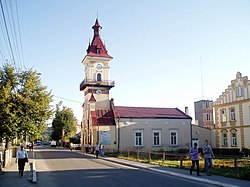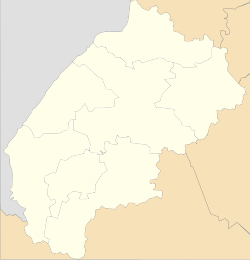Rava-Ruska(Ukrainian:Рава-Руська,IPA:[ˈrɑwɐˈrusʲkɐ];Polish:Rawa Ruska;Yiddish:ראווע,romanized:Rave) is acityinLviv Raion,Lviv Oblast,westernUkraine.It is aborder townbetween Ukraine andPoland.Theborder checkpointis situated 8 km (5 mi) west of the city, along the international autorouteWarsaw–Lviv.Rava-Ruska hosts the administration ofRava-Ruska urban hromada,one of thehromadasof Ukraine.[1]Its population is approximately8,494 (2022 estimate).[2]
Rava-Ruska
Рава-Руська Rawa Ruska | |
|---|---|
 City hall | |
| Coordinates:50°13′30″N23°37′27″E/ 50.22500°N 23.62417°E | |
| Country | |
| Oblast | Lviv Oblast |
| Raion | Lviv Raion |
| Hromada | Rava-Ruska urban hromada |
| Founded | 1455 |
| Named for | Rawa Mazowiecka |
| Area | |
• Total | 8.5 km2(3.3 sq mi) |
| Elevation | 349 m (1,145 ft) |
| Population (2022) | |
• Total | 8,494 |
| • Density | 1,000/km2(2,600/sq mi) |
 | |
History
edit| Year | Pop. | ±% |
|---|---|---|
| 1921 | 8,970 | — |
| 1931 | 11,146 | +24.3% |
| 2022 | 8,494 | −23.8% |
| Source:[3] | ||
Rawa-Ruska was founded in 1455 by the Polish princeWładysław I of Płock,Duke ofBełzandMazovia.He added the suffix "Ruska", meaning "Ruthenian" (during this time, the urban Ukrainian inhabitants were referred to as "Ruthenians" ), to distinguish it fromRawa Mazowieckalocated further west. Due to a convenient location along the merchant trail fromLublintoLviv,the newly located town quickly developed. For centuries, Rawa was part of theKingdom of Polandand thePolish–Lithuanian Commonwealth.It remained in private hands of several consecutiveszlachtafamilies, such as the Głogowski, Suchodolski, Rzeczycki and Bogusz. In 1622, the town received permission of the King of Poland to organize fairs. In 1672, a skirmish between Polish andCrimean Tatarforces took place here, in which Polish unit underAtanazy Miączyńskifreed hundreds of captured peasants. In 1698, Rawa was the site of a meeting betweenPeter the GreatandAugustus the Strong,which led to theTreaty of Preobrazhenskoyein 1699.
From theFirst Partition of Polandin 1772 until the end of World War I in 1918, the town was part of theAustrian Partitionruled first by theAustrian Empireand then byAustria-Hungaryafter thecompromise of 1867.It was a seat of the Rawa Ruska district, one of the 78BezirkshauptmannschafteninAustrian Galiciaprovince (Crown land) in 1900.[4]In 1880, its population was 10,500, with 37% Jews, 35% Poles, 20% Germans and 7% Ukrainians. In 1857, Rawa received a rail connection withJarosław,and next year, the railroad reachedSokal.
20th century
editIn the early 20th century, Rava-Ruska developed into a rail junction, with a connection toLvivandRejowiec,built in 1915. After therebirth of PolandRawa-Ruska became part of theLwów Voivodeship,and the seat of the Powiat Rawski county (area 1,401 km2(541 sq mi)). The line from to Rejowiec was of leading importance, as it connected the two main cities of Poland,Warsaw,andLviv.Due to the rail lines, Rawa prospered, and several businesses operated in the town. In 1924, a Belgian company opened here a factory ofrailroad ties.Furthermore, inthe interbellum periodRawa Ruska was home to Main School ofthe Border Guard,which was moved there in 1928 fromGóra Kalwaria.The school had a department of training of guard dogs, also located in Rawa-Ruska.
According toPolish census of 1921,the population of the town was 8,970; with 42% Poles, 42% Jews and 14% Ukrainians. By 1938, the population increased to 12,000.
World War II and the Holocaust
editOn 14 September 1939, during theInvasion of Poland,Rava-Ruska was captured by theWehrmacht.The German troops left the town within days in accordance with theGerman–Soviet Frontier Treaty,and Rava-Ruska was occupied by the Soviet forces. A year and a half later, on the 28 June 1941, it was recaptured by the Germans during the German invasion of the Soviet Union,Operation Barbarossa.TheUkrainian People's Militsiyawas formed.[5]The town was incorporated into theGeneral Governmentterritory.
TheJudenratwas established in July 1941.[5]In March 1942 the nearbyBelzec extermination campbegan its killing operations, and at the end of the month the first transport of 1,000 Jews left Rava-Ruska forBelzec.[5]Many Jewish residents were killed at Belzec in further deportations, usually organized by the Germans and assisted by the Ukrainian police and civilian volunteers.[6][7]Approximately 5,000Polish Jewsfrom Rava-Ruska were shot during a liquidationAktionbetween 7 and 11 December 1942. The last mass shootings of Jews occurred in June 1943, during which 300-400 Jews were killed in a forest outside the village.[8]
The Germans also operated the Stalag 325prisoner-of-war campforFrenchand Belgian POWs in the town, following its relocation fromZamośćand before its further relocation toLwów.[9]There were poor conditions in the camp with POWs being subjected to harassment and beatings by the German guards and suffering from hunger and epidemics, resulting in a high death rate.[9]Many POWs were sent toforced laboursubcamps in the region, and the local populace shared food with the prisoners despite the danger.[9]
After World War II
editAfterWorld War II,the Polish community of Rava-Ruska was forced to abandon the town and move to theRecovered Territories.Nevertheless, Rava-Ruska remains one of the key centres of the Polish minority in Ukraine, with the local office of theAssociation of Polish Culture of the Lviv Landoperating here.
Until 18 July 2020, Rava-Ruska belonged toZhovkva Raion.The raion was abolished in July 2020 as part of the administrative reform of Ukraine, which reduced the number of raions of Lviv Oblast to seven. The area of Zhovkva Raion was merged into Lviv Raion.[10][11]
Geography
editClimate
edit| Climate data for Rava-Ruska (1981–2010) | |||||||||||||
|---|---|---|---|---|---|---|---|---|---|---|---|---|---|
| Month | Jan | Feb | Mar | Apr | May | Jun | Jul | Aug | Sep | Oct | Nov | Dec | Year |
| Mean daily maximum °C (°F) | 0.2 (32.4) |
1.6 (34.9) |
6.6 (43.9) |
14.0 (57.2) |
19.8 (67.6) |
22.3 (72.1) |
24.3 (75.7) |
23.9 (75.0) |
18.6 (65.5) |
13.2 (55.8) |
6.4 (43.5) |
1.3 (34.3) |
12.7 (54.9) |
| Daily mean °C (°F) | −2.7 (27.1) |
−1.8 (28.8) |
2.2 (36.0) |
8.3 (46.9) |
13.8 (56.8) |
16.6 (61.9) |
18.5 (65.3) |
17.8 (64.0) |
13.1 (55.6) |
8.3 (46.9) |
2.9 (37.2) |
−1.4 (29.5) |
8.0 (46.4) |
| Mean daily minimum °C (°F) | −5.6 (21.9) |
−5.0 (23.0) |
−1.5 (29.3) |
3.1 (37.6) |
8.2 (46.8) |
11.4 (52.5) |
13.3 (55.9) |
12.5 (54.5) |
8.6 (47.5) |
4.4 (39.9) |
-0.0 (32.0) |
−4.0 (24.8) |
3.8 (38.8) |
| Averageprecipitationmm (inches) | 35.5 (1.40) |
35.5 (1.40) |
41.7 (1.64) |
44.1 (1.74) |
77.9 (3.07) |
76.3 (3.00) |
90.1 (3.55) |
77.5 (3.05) |
70.3 (2.77) |
44.0 (1.73) |
43.6 (1.72) |
40.0 (1.57) |
676.5 (26.63) |
| Average precipitation days(≥ 1.0 mm) | 8.7 | 9.1 | 8.7 | 8.5 | 10.9 | 10.5 | 10.4 | 8.5 | 9.0 | 7.5 | 9.5 | 9.8 | 111.1 |
| Averagerelative humidity(%) | 84.1 | 82.0 | 77.7 | 70.6 | 71.4 | 74.4 | 75.3 | 75.8 | 80.0 | 81.3 | 84.9 | 86.0 | 78.6 |
| Source:NOAA[12] | |||||||||||||
Transportation
editIt is located near the border withPoland,opposite the town ofHrebenne.Through the city passes the European routeE372.At the border there is a "checkpoint Rava-Ruska".
Rail station
editThe city has arailroad stationwhich also has a border and customs checkpoint. Since 2005 it has been used exclusively for freight transportation only and has two directions, one towards Hrebenne, another towardsWerchrata.
Points of interest
edit- Parish church of St. Joseph, built in 1700 - 1776 upon the initiative ofCastellanof Belz Andrzej Rzeczycki. During theSovietera the church served as a warehouse.
- Franciscan Abbey of Archangel Michael, founded in 1725 byStarostaof Belz Grzegorz Rzeczycki and Jozef Glogowski. The complex of the abbey and the church was completed in 1737 by architect Pawel Fontana, and was one of the most interesting sights of the town. In the Soviet Union, the complex was turned into a warehouse serving the local collective farm.
Notable people
edit- Maurice Abraham Cohen,educator and linguist
- Iryna Vereshchuk,deputy prime minister of Ukraine
- Walter V. Bozyk,conductor,bandurist
- Oswald Frank (born 1887),Polish Armygeneral
- Olgierd Gorka (born 1887), Polish historian and diplomat
- Michal Dadlez (born 1895), Polish poet
- Edward Olearczyk(born 1915), Polish composer
See also
editReferences
edit- ^"Рава-Руська міська громада"(in Ukrainian). Портал об'єднаних громад України.
- ^Чисельність наявного населення України на 1 січня 2022[Number of Present Population of Ukraine, as of January 1, 2022](PDF)(in Ukrainian and English). Kyiv:State Statistics Service of Ukraine.Archived(PDF)from the original on 4 July 2022.
- ^Wiadomości Statystyczne Głównego Urzędu Statystycznego(in Polish). Vol. X. Warszawa: Główny Urząd Statystyczny. 1932. p. 140.
- ^Wilhelm Klein (1967),Die postalischen Abstempelungen auf den österreichischen Postwertzeichen-Ausgaben 1867, 1883 und 1890.[clarification needed]
- ^abcChris Webb; Chip Sother (2011)."Rawa Ruska".H.E.A.R.T.HolocaustResearchProject.org.Retrieved21 October2015.
- ^Megargee, g (2012).Encyclopedia of Camps and Ghettos.Bloomington, Indiana: University of Indiana Press. p. 8199-20.ISBN978-0-253-35599-7.
- ^"Holocaust by Bullets".Yahad-in Unum.Retrieved19 June2020.
- ^Yahad-In Unum."Execution Sites of Jewish Victims Investigated".Yahad Map.org.Retrieved18 December2014.
- ^abcMegargee, Geoffrey P.; Overmans, Rüdiger; Vogt, Wolfgang (2022).The United States Holocaust Memorial Museum Encyclopedia of Camps and Ghettos 1933–1945. Volume IV.Indiana University Press, United States Holocaust Memorial Museum. pp. 315–317.ISBN978-0-253-06089-1.
- ^"Про утворення та ліквідацію районів. Постанова Верховної Ради України № 807-ІХ".Голос України(in Ukrainian). 2020-07-18.Retrieved2020-10-03.
- ^"Нові райони: карти + склад"(in Ukrainian). Міністерство розвитку громад та територій України.
- ^"World Meteorological Organization Climate Normals for 1981–2010"(XLS).National Centers for Environmental Information.Archived fromthe original(XLS)on 17 July 2021.Retrieved17 July2021.



